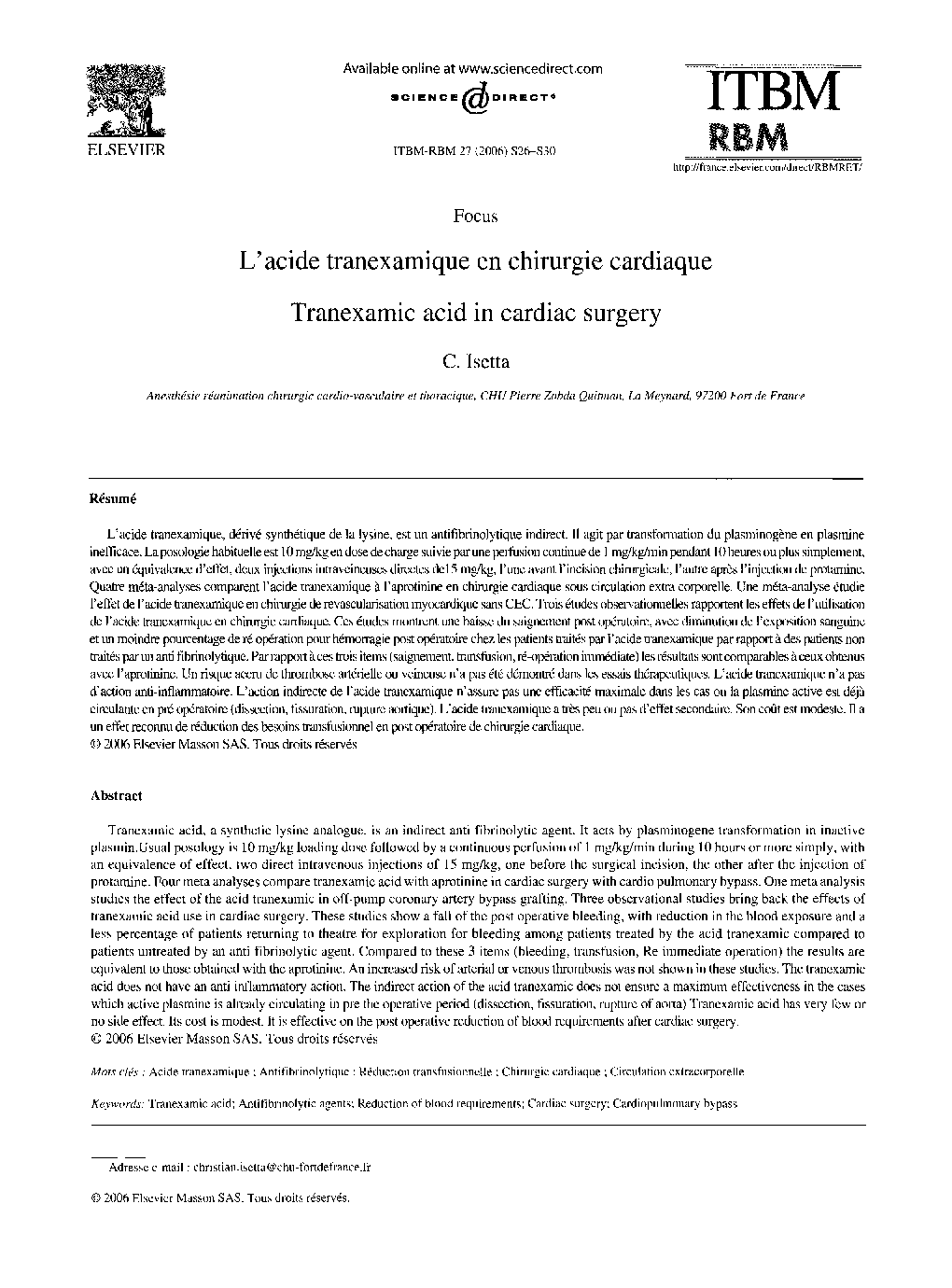| کد مقاله | کد نشریه | سال انتشار | مقاله انگلیسی | نسخه تمام متن |
|---|---|---|---|---|
| 871676 | 910122 | 2006 | 5 صفحه PDF | دانلود رایگان |

RésuméL'acide tranexamique, derive synthétique de la lysine, est un antifibrinolytique indirect. It agit par transformation du plasminogene en plasmine inefficace. La posologie habituelle est 10 mg/kg en dose de charge suivie par une perfusion continue de 1 mg/kg/min pendant 10 heures ou plus simplement, avec un equivalence d'effet, deux injections intraveineuses directes del5 mg/kg, l'une avant ('incision chirurgicale, I'autre après ('injection de prolamine. Quatre méta-analyses comparent l'acide tranexamique a l'aprotinine en chirurgie cardiaque sous circulation extra corporelle. Une méta-analyse étudee l'effet de I'acide tranexamique en chirurgie de revascularisation myocardique sans CEC. Trois etudes observationnelles rapportent les effets de ('utilisation de I'acide tranexamique en chirurgie cardiaque. Ces etudes montrent une baisse du saignement post operatoire, avec diminution de ('exposition sanguine et un moindre pourcentage de re operation pour hémorragie post opératoire chez les patients traités par I'acide tranexamique par rapport a des patients non traités par un anti fibrinolytique. Par rapport a ces trois items (saignement, transfusion, re-operation immediate) les résultats sont comparables a ceux obtenus avec l'aprotinine. Un risque accru de thrombose artérielle ou veineuse n'a pas été démontré dans les essais thérapeutiques. L'acide tranexamique n'a pas d'action anti-inflammaaoore. L'action indirecte de I'acide tranexamique n'assure pas une efficacité maximale dans les cas ou la plasmine active est déjà circulante en pre opératoire (dissection, fissuration, rupture aortique). L'acide tranexamique a très peu ou pas d'effet secondaire. Son coût est modeste. Il a un effet reconnu de reduction des besoins trarisfusionnel en post opératoire de chirurgie cardiaque.
Tranexamic acid, a synthetic lysine analogue, is an indirect anti fibrinolytic agent. It acts by plasminogene transformation in inactive plasmin.Usual posology is 10 mg/kg loading dose followed by a continuous perfusion of I mg/kg/min during 10 hours or more simply, with an equivalence of effect, two direct intravenous injections of 15 mg/kg, one before the surgical incision, the other after the injection of prolamine. Four meta analyses compare tranexamic acid with aprotinine in cardiac surgery with cardio pulmonary bypass. One meta analysis studies the effect of the acid tranexamic in off-pump coronary artery bypass grafting. Three observational studies bring back the effects of tranexamic acid use in cardiac surgery. These studies show a fall of the post operative bleeding, with reduction in the blood exposure and a less percentage of patients returning to theatre for exploration for bleeding among patients treated by the acid tranexamic compared to patients untreated by an anti fibrinolytic agent. Compared to these 3 items (bleeding, transfusion, Re immediate operation) the results are equivalent to those obtained with the aprotinine. An increased risk of arterial or venous thrombosis was not shown in these studies. The tranexamic acid does not have an anti inflammatory action. The indirect action of the acid tranexamic does not ensure a maximum effectiveness in the cases which active plasmine is already circulating in pre the operative period (dissection, fissuration, rupture of aorta) Tranexamic acid has very few or no side effect. Its cost is modest. It is effective on the post operative reduction of blood requirements after cardiac surgery.
Journal: ITBM-RBM - Volume 27, Supplement 1, December 2006, Pages S26-S30